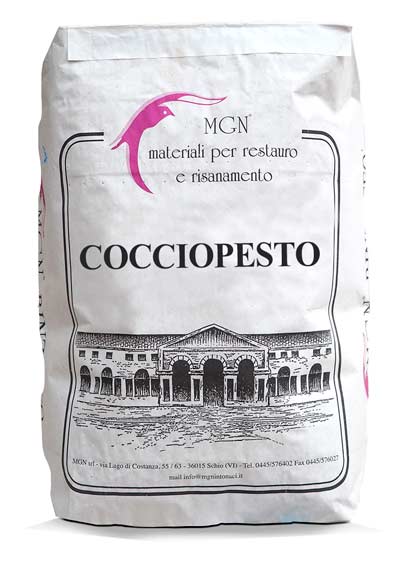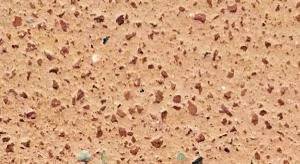Description & Historical Background
COCCIOPESTO plaster is an ancient Roman lime plaster, used since about 500 B.C., traditionally made of pure slaked lime mixed with crushed tile or brick powder. Initially a Phoenician plaster adopted by the Romans, it has been widely used in the construction of aqueducts, Roman baths, roads and underfloor areas.
The plaster can be applied both internally and externally, its breathability and hydro-regulating capacity makes it ideal for the natural restoration of damp walls. It can also be used for the protection of walls in direct contact with water. It can have colors ranging from yellow ocher to light red, depending on the color of the bricks used.
Cocciopesto plasters can be found in a lot of archaeological areas and historic buildings throughout Europe as the Romans have "exported" and used this plaster throughout the former Roman Empire. It is an ideal material for bio-architectural applications because it is 100% natural, it breaths, it's an excellent humidity regulator and it also looks beautiful.
Here is a short video from Venetian restoration Master Naldo Busato on how Cocciopesto plaster was used for the waterproofing of Roman baths and wells.
Cocciopesto MGN is a true Cocciopesto plaster as described by Marcus Vitruvio (a Roman architect and military engineer during the 1st century known for his famous 10 volume work "On Architecture") and other architectural writers 2,000 years ago.
MGN selects the best bricks (fired in a traditional way at low temperatures) and the best natural lime, mixing them into a product that is easy-to-use even with modern construction tools. It is naturally elastic, a quality that makes it suitable for old walls. It is also recommended for the reconstruction of cornices and mouldings due to its excellent workability.
The plaster improves the comfort of your building because:
- The natural hygroscopicity of the fired brick powder combined with the natural porosity of lime regulates the humidity of the internal environment by acting as a hygrometric buffer.
- It improves the thermal performance of the building, keeping the walls dry.
- It is a highly breathable plaster that prevents the formation of mould due to moisture stagnation.
- Thanks to the thermal capacity and thermal inertia of the brick dust (terracotta), cocciopesto plasters function as an energy reservoir: saving energy, evening out temperature oscillations, improving overall thermal comfort.
Once set, a natural lime finish, such as Calcina Fine, Intonachino Arenino or Marmorino, can also be applied on top.

Typical Applications
Renovation, Restoration, New build, Timber frame buildings, Straw, Hemp Blocks, Rising Damp
Technical Data
Here is some key technical data. Please see technical sheet below for more information.
Granular size | 0 - 4 mm |
pH | 10.5 |
Vapour diffusion resistance (μ) | 8.5 |
Thermal conductivity (λ) | 0.49 |
Compressive strength (N / m²) | 2.6 |
Adhesion (N / m²) | 0.1 |
Weight (kg / m³) | 1400 |
Consumption (kg / m² area / cm thickness) | 16 |
Bag weight (kg) | 25 (48 bags per pallet) |
Water intake (l / bag) | 4.5 - 5.5 |
Composition
- Hydrated lime, with more than 90% calcium hydroxide (CL90S as per EN459-1 standard)
- NHL3.5 Hydraulic lime, desalinated white
- Brick powder / crushed bricks (cooked at low temperature, graded 0 - 4 mm)
- Pozzolans
- Marble powder
Colour
Red (Brick colour)

Downloads
Cocciopesto MGN - Italian technical sheet
English technical sheet will be available shortly.

